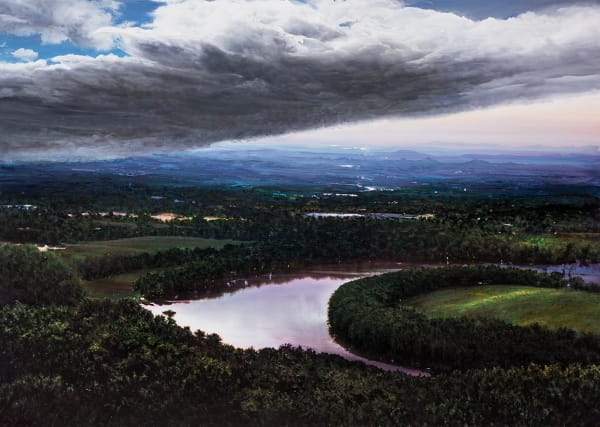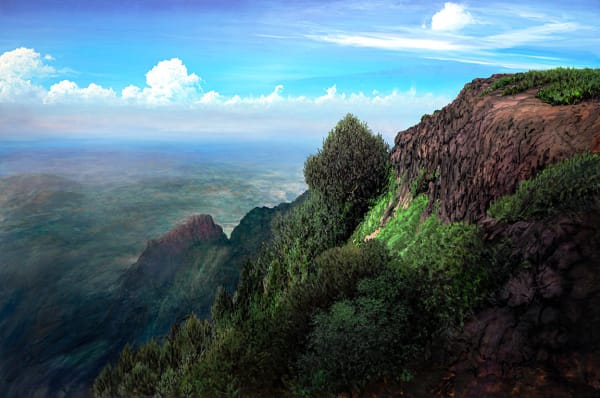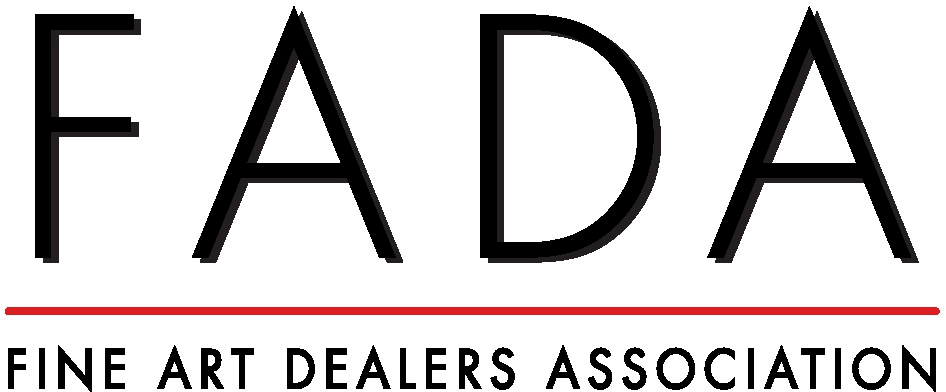Although none of the subjects is literal, the powerful images Telfair recollects from her childhood and extensive travels inform each painting she creates. Throughout her career, Telfair has conceived all her landscape subjects from vivid imagination; remembering places she may have visited, or that may not actually exist. Her landscapes are lush and romantic, showing us the sublime grandeur of these fantastical places conjured with exceptional detail. Abrams Books published a monograph on Tula Telfair's work entitled Invented Landscapes with Essays by Henry Adams, J. Michael Fay and Michael Roth in 2016.
Tula Telfair, a resident of Old Lyme, Connecticut, is a professor of Art at Wesleyan University in Middletown. Since 1978, her work has been exhibited at museums from Pennsylvania to California and galleries from New York to Sri Lanka. Telfair's paintings may be found in numerous museum and public collections.
-
Thoughts on the work
By Tula TelfairWilderness Does Not Locate Itself
In this body of work, I explore Wilderness in the form of recalled and imagined landscape in order to acknowledge both its inherent power and remarkable fragility. Statistics indicate that only one quarter of the Earth's terrestrial surface is covered by wilderness or land areas not significantly modified by human activity. Today, we know that all our activities impact even the most distant regions of this planet, so perhaps Wilderness only exists in our memories or on a canvas.
I spent my formative years living in the jungles that bordered the Ivindo River in Gabon, which is on the Equator in West Central Africa. I used to love listening to my father talk about mapping the Amazon on foot and his other countless challenging explorations of the most remote parts of this planet. Today, I make paintings that archive my responses to the natural world - images that I hope are both familiar and foreign. The remote locations in these invented landscapes are inspired by areas where change is rapidly occurring. My recent work is informed by visits to active volcanoes, locations where tectonic plates meet and earthquakes occur daily, the solitary Arctic and Antarctic regions, and isolated areas in Africa. I am currently doing research on shifting rivers and coastlines and their impact on the edges of the lands they border. Ultimately, I am fascinated by the subjectivity of perception and the power of memory to anchor our place in the world.
As I paint, I try to capture what it felt like moving through a location, recalling how the terrain shifted, how soft or hard it was under my feet, how the sun or wind felt coming into contact with my skin, and the smells and sounds I experienced navigating the area. These vivid yet visceral memories inform the technical decisions I make. Starting with a blank canvas, I work intuitively and the image changes countless times until the piece triggers a Déjà vu experience. The surface of each painting is extremely varied and heavily layered. Some paintings conceal more than 10 different images below the final one. I use a multitude of painting techniques, picking and choosing where and when the paint will be smooth or rough or creamy or thick or thin in order to facilitate a corporal reaction from the viewer. These works appear to be photographs from a distance, but as one approaches - the landscape image dissolves into an abstract, physically varied and fully material surface that also becomes a site for investigation, serving as an archive of my actions and decisions and a record of my intellectual and emotional explorations.
-
-
 Tula Telfair, GAPS AND RIFTS, 2022
Tula Telfair, GAPS AND RIFTS, 2022 -
 Tula Telfair, REPRESENTS ONLY A PART, 2018
Tula Telfair, REPRESENTS ONLY A PART, 2018 -
 Tula Telfair, FRAGILE EQUILIBRIUM, A, 2022
Tula Telfair, FRAGILE EQUILIBRIUM, A, 2022 -
 Tula Telfair, DEFINED BY ITS EDGES, 2022
Tula Telfair, DEFINED BY ITS EDGES, 2022
-
-
Wilderness Does Not Locate Itself
Essay by Lauren PiemontThere comes a point in the process of painting when the painting takes on a life of its own, regardless of its subject matter or style. Even representational painters stop observing the landscape, object or figure at this phase. The painting shifts into its own territory, becoming an independent entity to be shaped and resolved. Every painting, and arguably anything else born of the creative process, reaches this stage and ascends to something greater than the sum of its parts. Tula Telfair makes use of this phenomenon but pushes her work to venture even further beyond it. Her monumental, imagined landscapes, fully rendered in a style akin to photorealism, feel and function like real locations on the map. Telfair, an avid traveler who spent her childhood in Africa, Asia and Europe before returning to the United States, certainly has a large memory bank of locales to draw from when she is developing her compositions. Although memory plays a prominent role, it is not the whole story. The landscapes have been liberated to fulfill a purpose beyond mere documentation. Wilderness Does Not Locate Itself articulates a particular purpose: the wild mystery of nature does not willingly reveal itself. It is and will always remain a great unknown. Telfair's most recent group of paintings help us begin to sense what we can only surmise.
A variety of moods are on display in Wilderness Does Not Locate Itself— from the idyllic, verdant and expansive to the foreboding, threatening and obstructive. The Image Repertoire (2022) depicts the view at the top of a mountain. The mountainside is covered in lush greenery and the sky is an electric blue, dashed with a line of cumulus clouds. Viewers are instantly transported to this fictional place and perhaps even reminded of the mountains they have scaled to take in a view. A Fragile Equilibrium (2022), on the other hand, offers stormy skies that hang over a river bend surrounded by thick forest and green clearings. Mountains appear in the distance, but so do hints of human-made structures, placing viewers squarely within the reaches of the picture plane. A more balanced and familiar version of life is illustrated here. The Place Where We Strayed (2022) is one of the more disquieting scenes in the exhibition. Viewers find a snowy hilltop dotted with trees or scrubby bushes up to its crest. The white snow is cast in warm shadow by the dark, red-streaked sky behind it. It is not clear if the sunset or something more calamitous is at cause, but it is clear that the situation is inescapable.
What are viewers to make of the varied group of environments presented in Wilderness Does Not Locate Itself? Telfair proclaims that her career-long purpose is to create something like a composite portrait of the natural world, but a greater effect is realized. Through her near-religious reverence for nature and her technical skill in painting, she captures nature's agency in the process, too. Swept Away and Replaced by Another (2022) is an especially stirring work. It portrays a crater ringed in fire. Glowing coals surround and fill the crater, while the horizon line is delineated by a swipe of paint that appears white-hot. The title certainly implies catastrophe but nothing in the image indicates what may have prompted it. Only the fiery aftermath is visually evident. The Question of Ownership (2022) functions as a reminder that the constructed world has been left behind. An unkempt thicket that spills over the canvas's edges is an apt rebuttal to human attempts at laying claim to land. A Utopian Gesture (2022) sends a message of benevolence on nature's terms. A river snakes through a sweeping vista and wispy clouds sit just above a sky as blue as crystal clear Caribbean waters.
In today's political landscape, Telfair's work might stir associations with climate change, but this is not her explicit intent. She believes in responsible stewardship of the earth and is intimately familiar with the myriad of ways in which human activity ripples through and alters the natural world, but she chooses nature as her subject simply out of deep admiration and an inexhaustible sense of wonder. The viewer is left to bring their own associations into her imagined environments and take from them whatever it is they most need.
Boundlessness is the strongest force at work in all of Telfair's paintings. It is tempting to solely read them as warnings against human-driven climate change. It is equally tempting to see them as dream-like ideals or try to tease out the elements of reality they contain. While none of these readings are wholly untrue, they do not describe the totality of the result. Wilderness is that way— as hard as we may try to categorize, catalogue, map or conquer it, it will always be bigger than us and too unwieldy for our language and systems to contain. Art is that way, too. Taken with the artist's biography and the pressing issues of the day, we might believe we can analyze and trace the image before us, but of course there is always more. This dance between what we think we know and what we never truly will is precisely what makes Telfair's work so endlessly alluring.
Tula Telfair's exhibition will be on view through December 24. Please send all inquiries to gallery@jeraldmelberg.com.
















